Inside Lambeth Palace
Morton's Tower
Morton's Tower is the impressive and familiar red brick Tudor gatehouse with two five story battlement towers, which forms the entrance to the modern Palace buildings and grounds. It was built by Cardinal John Morton in around 1490.
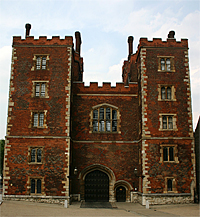 Morton himself lived in the Tower for a short time and used the large room in the centre of the tower above the larger of the two gates as an audience chamber.
Morton himself lived in the Tower for a short time and used the large room in the centre of the tower above the larger of the two gates as an audience chamber.
"The Lambeth Dole", a daily offering of bread, broth and money was first instigated by Archbishop Winchelsea in the thirteenth century. This ritual of charitable giving was offered from Morton's Tower until 1842.
The ground floor of the south battlement tower contains a small cell which was briefly used for imprisonment in the 16th century. Two iron rings can still be found fixed to the wall.
When Thomas More joined the staff of Lambeth Palace at the age of twelve to gain an education in the workings of a prominent household he is thought to have lived in the Tower during the course of his stay.
As the main entrance to Lambeth Palace Morton's Tower is staffed daily by a team of gatekeepers. The location of the gatekeepers lodge remains unchanged from when the Tower was built.
Above the gatekeeper's rooms and forming the rest of the Tower are storage and work rooms for the staff of the Lambeth Palace Library. Here are housed a book restoration centre, as well as offices and storage space for some of the libraries 230,000 books, texts and manuscripts.
The Atrium
The glazed roof courtyard now known as the Atrium was designed and built by Richard Griffith and Richard Scott and opened in the year 2000 by HRH the Prince of Wales. It connects the main Palace building to the thirteenth century Chapel and Crypt.
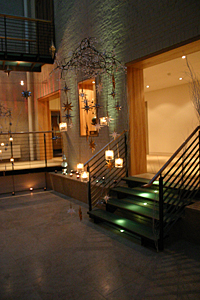 Work was completed following a grant to the Church Commissioners from the Heritage Lottery Fund. The project formed part of the Palace's millennium celebrations in 2000 and enabled the building to be open to the general public for a year as part of London's "String of Pearls" initiative.
Work was completed following a grant to the Church Commissioners from the Heritage Lottery Fund. The project formed part of the Palace's millennium celebrations in 2000 and enabled the building to be open to the general public for a year as part of London's "String of Pearls" initiative.
Richard Griffith Architects were shortlisted for the RFAC building of the Year Award in 2001 for its contemporary yet sympathetically integrated design.
Part of the Atrium is now decorated by a modern abstract painting entitled "Dream Dreams". The work was commissioned for the space by Liz and Barry Smith in memory of their son Rupert who died in an accident at the age of 18. Youthful energy is suggested in the vibrant colours and shapes.
During the course of the building work on the Atrium many artefacts were found on the site, including fragments of medieval roof and floor tiles, medieval pottery, Mesolithic flint, iron nails and an oyster shell dating from the 13th century.
The room is now used primarily as an area for entertaining, with many buffet and drinks receptions held here. The Atrium also serves as a place where staff can meet together, often with the Archbishop, after the weekly community Eucharist in the Crypt Chapel.
The Chapel
The Chapel at Lambeth Palace has been the private chapel of Archbishops of Canterbury since the early 13th century. The lower part of the east wall of the Chapel is thought to be the earliest surviving structure found on the site.
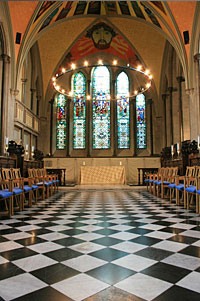 Unlike the Crypt directly below, the appearance of the Chapel has been changed many times over the centuries.
Unlike the Crypt directly below, the appearance of the Chapel has been changed many times over the centuries.
Upon his arrival at Lambeth, Archbishop Laud made many alterations to the Chapel. The installation of black and white marble chequered flooring and the decoratively carved screen are two of those changes that can be seen today. Laud also found the Chapel windows to be inadequate, describing them as "all shameful to look on, all diversely patched like a poor beggars coat". However, the decorative design of his new windows were not popular with puritans who subsequently smashed every pane. The Chapel was eventually restored by Archbishop Juxton, following the succession of Charles II.
A vaulted ceiling was installed by Edward Blore in 1846. This replaced the flat ceiling, complete with Archbishop's crest, which had been a part of Laud's innovations.
The Chapel was heavily damaged following a direct hit by an incendiary bomb during World War II when the ceiling was lost and all of the windows were broken. Scorch marks can still be seen on the marble tiled floor. Restoration was begun in 1955 by architects Lord Mottistone and Mr Paul Paget. Modern glass was inserted into the remaining window frames by Carl Edwards and Hugh Powell who attempted to recreate the same themes and designs as the original windows designed by Morton in 1486.
The present day ceiling artwork entitled 'From Darkness to Light' was painted by Leonard Henry Rosoman in 1988. The panels depict Pope Gregory the Great commissioning Saint Augustine to visit England in AD 597. St. Thomas à Becket is shown as a young man hunting, in a reference to the image that can be found alongside a depiction of his murder in Canterbury Cathedral in 1170. The central panels show the enthronement of Archbishop Parker and scenes from the first Lambeth Conference. The last image above the altar shows Christ in Glory.
The ashes of Archbishop Parker are buried beneath one of the floor tiles in front of the altar in the Chapel at Lambeth. His remains are placed near the spot where he was consecrated as the first Archbishop of Elizabeth I and he is the only person to have been buried at Lambeth Palace.
A small room above the present day vestry with a balcony overlooking the Chapel was used by Archbishop Thomas Cranmer. It is thought that in this room Cranmer compiled the first Book of Common Prayer.
The Chapel is still used regularly today as a place of prayer and worship.
Lollard's Tower
Seven iron rings remain attached to the wood-lined walls and graffiti left by the prisoners can be found carved into the wood.
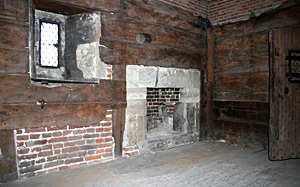
Lollard's Tower was formally known as Chichele's Tower and is situated to the west of the Chapel. The post room on the first floor once served as an audience chamber for Archbishop Chichele between 1414 and 1443.
The tower also has a bell turret with a 1687 bell and outside an empty niche, which once containing a statue of St Thomas of Canterbury. For many years boatmen passing on the river doffed their hats to the statue until it was removed by order of Henry VIII.
During a Second World War air raid on the 10th May 1941 much of the tower was gutted. Parts of the wooden prison are now supported and protected by a brick surround.
The Crypt Chapel
The Crypt Chapel as it is now known is the oldest remaining section of Lambeth Palace
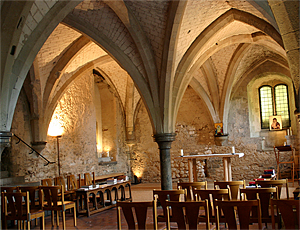 It is thought that the vaulted undercroft and chapel at Lambeth Palace was completed in 1220. The chapel was initially a free-standing building with an external stair on the west end, although it is now connected with the rest of the palace building at several points.
It is thought that the vaulted undercroft and chapel at Lambeth Palace was completed in 1220. The chapel was initially a free-standing building with an external stair on the west end, although it is now connected with the rest of the palace building at several points.The Crypt was not originally designed for use as a chapel but was first used as a storage area for beer and wine. The Floor level was raised, probably in the first half of 13th century because of flooding from the Thames. The window seats in this room are higher, giving an indication of where the 13th Century floor level came to, approximately three feet above the floor level today. The floor was returned to its original level by architect W. D. Caröe in 1907.
The Crypt was first used as a chapel temporarily during World War II when the main chapel was destroyed. William Temple also used The Crypt as an air raid shelter at the beginning of The War and invited local people to take shelter.
The Crypt became a permanent chapel in 1987 when Archbishop Runcie commissioned the decoration of the main Chapel at Lambeth.
A Fresco of Christ in Glory, which hangs on the wall in the Crypt was given by Pope Paul VI to Archbishop Ramsey in 1966. This gift marked the first official meeting between The Archbishop of Canterbury and The Papacy since the 16th century.
Today the crypt chapel is an oasis of peace and calm. It is loved by Archbishop Williams and much used as a place for both worship and meetings. Nicolas Pevsner described the Crypt Chapel as "One of the best preserved medieval vaults in London".
The Guard Room
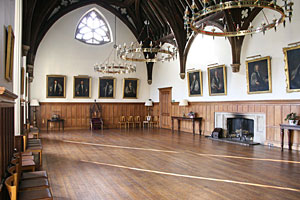 Initially it would have been the Archbishop's principle audience room and meetings and ceremonies would have taken place here.
Initially it would have been the Archbishop's principle audience room and meetings and ceremonies would have taken place here.The name Guard Room is a more recent term and derives from the time when the office of Archbishop warranted an army. This is where his armed soldiers would have gathered and where their weapons would have been stored.
In 1490 the 12 year old Thomas More was sent to Lambeth to be educated in a gentleman's household. He served as one of Cardinal Morton's pages and took part in household entertainments. He returned to Lambeth as Sir Thomas More on April 12th 1534 and it is said to have been in this room that he was summoned by Thomas Cromwell to swear an Oath of Supremacy declaring Henry VIII as head of the Church in England. By refusing to deny the authority of the Pope, Thomas More was led away from Lambeth to the Tower of London, where he was executed in 1535.
The magnificent arch-braced roof, a contemporary of that in Westminster Hall (across the river in the Palace of Westminster), predates the walls by some 400 years. When William Blore rebuilt the main Palace in 1830 he retained the roof, supporting it whilst rebuilding the walls.
The collection of paintings that can be found on display in this room are of Archbishops of Canterbury dating from 1602 to 1783, from the reigns of Elizabeth I to George III, respectively. Collectively they demonstrate the changing style of clerical dress during this period.
The first Lambeth Conference was held here in 1867, when 75 bishops were called by Archbishop Charles Longley for a meeting that marked the start of a tradition that continues today.
One of the more unusual artefacts on display at Lambeth Palace is the shell of a tortoise that once belonged to Archbishop William Laud. Laud brought the tortoise to Lambeth in 1633 as a pet, given to him as a gift from his college at Oxford. Ultimately the tortoise outlived Laud by over 100 years. It was accidentally killed at the age of 120, when in 1753 it was dug up out of hibernation in the Palace garden by a careless labourer and subsequently died of frost exposure.
The Guard Room is still used today for meetings, receptions and dinners.
The Pink Drawing Room
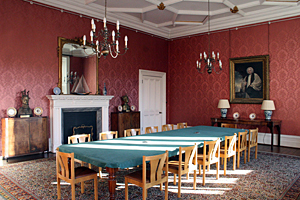 Decoration in the Pink Drawing Room includes two Nigerian figureheads, which were given to Archbishop Robert Runcie during his visit to Nigeria in 1982. The first was a gift from The University of Nigeria, Nsukka; the second from Chief Ambrose F. Alli on behalf of the government and people of the Bendel Sate of Nigeria.
Decoration in the Pink Drawing Room includes two Nigerian figureheads, which were given to Archbishop Robert Runcie during his visit to Nigeria in 1982. The first was a gift from The University of Nigeria, Nsukka; the second from Chief Ambrose F. Alli on behalf of the government and people of the Bendel Sate of Nigeria.The room contains several portraits, most notably one of Thomas Newton, former Bishop of Bristol. Despite being Bishop of Bristol, Newton is painted standing in front of St Paul's Cathedral as he was also named Dean of St Paul's in 1768.
The State Dining Room
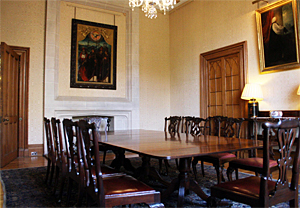 Visitors to the Palace, including The Queen, the Dalai Lama, senior Church leaders and prominent political figures from all over the world, have been entertained here. In addition, bishops and their wives are invited to dinner here on the eve of their consecration.
Visitors to the Palace, including The Queen, the Dalai Lama, senior Church leaders and prominent political figures from all over the world, have been entertained here. In addition, bishops and their wives are invited to dinner here on the eve of their consecration.The magnificent oil (on wood) painting over the fireplace is thought to have arrived at Lambeth with Cardinal Pole, but the artist is not known. It is entitled 'The Four Doctors of the Church' and shows St Jerome (with a lion), Pope Gregory, Ambrose and Augustine. The dove at the top bears faint slash marks, thought to have originated from a Parliamentarian sword.
The State Dining Room overlooks the garden and is connected to the State Drawing Room by a set of double doors.
The portraits on either side of the windows are of two Syrian orthodox bishops who visited during the late 19th century. On seeing them Queen Victoria is said to have sent money for Bibles to be printed in foreign languages.
The dining table (which extends to seat 12) is made of mahogany and rosewood.
The State Drawing Room
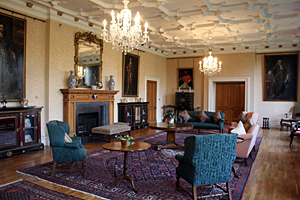 Much of this room was destroyed in 1944 during a Second World War air raid. It was austerely rebuilt in the 1950s although it wasn't until 1998 that Eileen Carey, wife of incumbent Archbishop George Carey, reupholstered the room and restored the moulded plaster work on the ceiling in accordance with Edward Blore's original 1828 design.
Much of this room was destroyed in 1944 during a Second World War air raid. It was austerely rebuilt in the 1950s although it wasn't until 1998 that Eileen Carey, wife of incumbent Archbishop George Carey, reupholstered the room and restored the moulded plaster work on the ceiling in accordance with Edward Blore's original 1828 design.The two crystal chandeliers were a gift from Waterford Glass.
The windows look out over the Lambeth Palace garden and a fireplace is situated in the opposing wall. To the left of the fireplace is a portrait of Charles I in Garter robes, with crown and orb. This painting is from the school of Van Dyck, and was possibly given to Archbishop Laud by the King. To the right of the fireplace is a portrait that is thought to depict Charles I's elder brother, Henry Prince of Wales who died 1612 at age of 18.
At the eastern end of the room is a late 17th century painting of Canterbury Cathedral. The painting is of great historic and architectural importance as it shows the missing north west tower of the Cathedral and the condition of the Corona at that time.